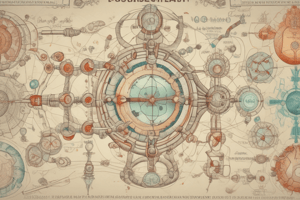Podcast
Questions and Answers
What is the chemical categorization of hormones?
What is the chemical categorization of hormones?
- Amino acid derivatives
- Peptide hormones
- Lipid derivatives
- All of the above (correct)
What are amino acid derivatives?
What are amino acid derivatives?
Hormones synthesized from an amino acid molecule, such as epinephrine from tyrosine.
What are the derivatives of tyrosine?
What are the derivatives of tyrosine?
Thyroid hormone and catecholamine (e.g., epinephrine).
What are the classes of amino acid derivative hormones?
What are the classes of amino acid derivative hormones?
What are derivatives of tryptophan?
What are derivatives of tryptophan?
What are peptide hormones?
What are peptide hormones?
What are glycoproteins?
What are glycoproteins?
What are the two classes of lipid derivatives?
What are the two classes of lipid derivatives?
What are eicosanoids derived from?
What are eicosanoids derived from?
What are steroid hormones derived from?
What are steroid hormones derived from?
What is the endocrine system?
What is the endocrine system?
What is the structural classification of hormones?
What is the structural classification of hormones?
What does the hypothalamus control?
What does the hypothalamus control?
What is a regulatory hormone?
What is a regulatory hormone?
What is the difference between releasing hormones and inhibiting hormones?
What is the difference between releasing hormones and inhibiting hormones?
Flashcards are hidden until you start studying
Study Notes
Chemical Classification of Hormones
- Hormones are classified into three main categories: amino acid derivatives, peptide hormones, and lipid derivatives.
Amino Acid Derivatives
- Synthesized from amino acids in simple steps.
- Example: Epinephrine, derived from tyrosine, is released from the adrenal medulla.
Derivatives of Tyrosine
- Includes thyroid hormones and catecholamines like epinephrine.
- Tyrosine sources: meat, dairy, and fish.
Classes of Amino Acid Derivative Hormones
- Consist of derivatives of tyrosine and derivatives of tryptophan.
Derivatives of Tryptophan
- Mainly melatonin.
- Tryptophan sources: turkey, chocolate, oats, bananas, dried dates, milk, cottage cheese, and peanuts.
Peptide Hormones
- Composed of chains of amino acids, often synthesized as prohormones.
- Prohormones can be converted to active hormones before or after secretion.
Glycoproteins
- Large hormones composed of more than 200 amino acids with carbohydrate side chains.
Short Polypeptides/Small Proteins
- Varied group includes short chain polypeptides (9 amino acids) and small proteins (up to 198 amino acids).
Lipid Derivatives
- Two main classes: eicosanoids and steroid hormones.
Eicosanoids
- Derived from arachidonic acid, affecting cellular activities and enzymatic processes.
- Prostaglandins play a critical role in coordinating local cellular activities.
Steroid Hormones
- Originating from cholesterol, released by reproductive organs.
- Testes produce androgens; ovaries produce estrogen and progesterone.
- Produced by adrenal cortex (corticosteroids) and kidneys (calcitriol).
- Steroid hormones bind to specific transport proteins, allowing longer circulation than peptide hormones.
Endocrine System
- Comprises organs dedicated to hormone or paracrine factor production.
- Hormones transported in extracellular fluid or bloodstream to target cells.
Structural Classification of Hormones
- Divided into amino acid derivatives (thyroid hormones, catecholamines, tryptophan derivatives), peptide hormones (glycoproteins or short polypeptide chains), and lipid derivatives (eicosanoids, steroid hormones).
Hypothalamus Control
- Functions to integrate the activities of the nervous and endocrine systems.
Regulatory Hormones
- Special hormones secreted by the hypothalamus that manage activity in the anterior lobe of the pituitary gland.
Releasing Hormones vs. Inhibiting Hormones
- Releasing hormones stimulate hormone release, while inhibiting hormones prevent it.
- Example: Prolactin-inhibiting hormone stops the release of prolactin.
- TSH stimulates the release of T1 and T2 from the thyroid, regulated by the hypothalamus based on T1 and T2 levels.
Studying That Suits You
Use AI to generate personalized quizzes and flashcards to suit your learning preferences.




